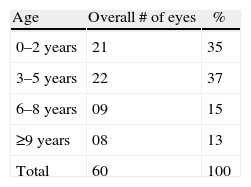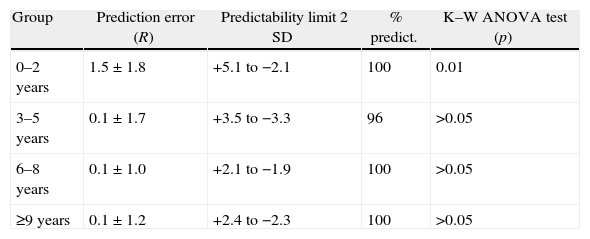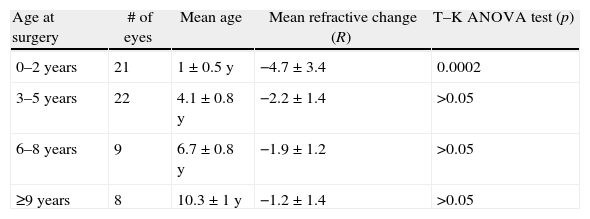Evaluate the predictability of the postoperative refraction and refractive changes in pediatric pseudophakia.
MethodsProspective, longitudinal follow-up on patients under the age of 15 years operated on for a cataract with intraocular lens, with 5 continuous years of follow-up. The patients were divided into 4 groups according to age at the time of the surgery: group from 0 to 2 years old, from 3 to 5 years old, from 6 to 8 years old, and 9 years and over. Error prediction and refractive change were studied. Statistical analysis was performed using the Student t and ANOVA test.
ResultsA total of 60 eyes were included (44 patients). No significant differences were found between the unilateral and bilateral group. The prediction error in the 0–2 years group was 1.5±1.8D, significantly higher than in the other groups (ANOVA P=0.01). Refractive change in 5 years of the group of 0–2 years was −4.7±3.4D (ANOVA p=0.0002), while in the other groups it was significantly lower, with no differences between them.
ConclusionsThe 0–2 years group was less hyperopic than expected, 100% within the accepted of 2 standard deviations, but with a high variability. The refractive change observed in this group coincides with previous reports that the largest growth and increase in axial length occurs during the first 2 years. The calculation and use of an IOL in children has a better immediate refractive prediction, and at long term in those older than 2 years of age.
Evaluar la predictibilidad de la refracción postoperatoria y la evolución refractiva en pseudofaquia pediátrica.
MétodosTrabajo prospectivo, longitudinal, en operados de catarata con lente intraocular, menores de 15 años, con 5 años continuos de seguimiento. Los pacientes fueron divididos según la edad en años al momento de la cirugía: grupos de 0 a 2 años, de 3 a 5 años, de 6 a 8 años y de 9 o más años. Se estudiaron error de predicción y cambio refractivo. Se realizó el análisis estadístico aplicando t de Student, test de Anova.
ResultadosSe incluyeron 60 ojos (44 pacientes). Sin diferencias significativas entre grupo unilateral y bilateral. El error de predicción fue de 1,5±1,8D en el grupo de 0 a 2 años, significativamente mayor que en los otros grupos (ANOVA p=0,01). El cambio refractivo a los 5 años del grupo de 0 a 2 años fue de −4,7±3,4D, (ANOVA p=0,0002) mientras en los otros grupos fue significativamente menor y sin diferencias entre grupos.
ConclusionesEl grupo de 0 a 2 años resultó menos hipermétrope de lo esperado, con un 100% dentro de lo aceptado de dos desviaciones estándar, pero con alta variabilidad. El cambio refractivo observado en este grupo coincide con trabajos previos en los que el mayor crecimiento y el aumento de la longitud axial ocurre durante los primeros dos años. El cálculo y utilización de una LIO en niños tiene mejor predicción refractiva inmediata y, a largo plazo, en mayores de 2 años de edad.
Artículo
Comprando el artículo el PDF del mismo podrá ser descargado
Precio 19,34 €
Comprar ahora









